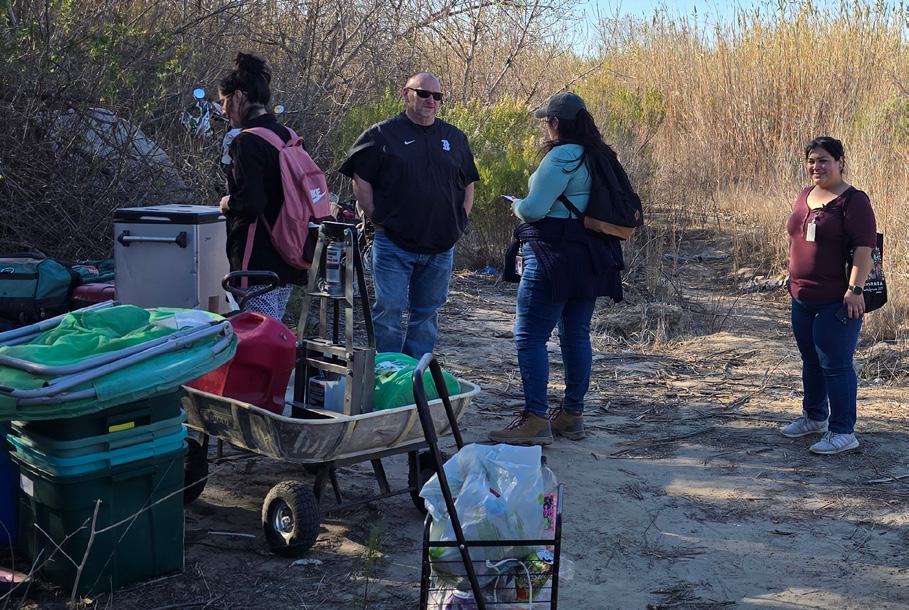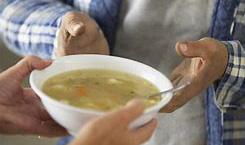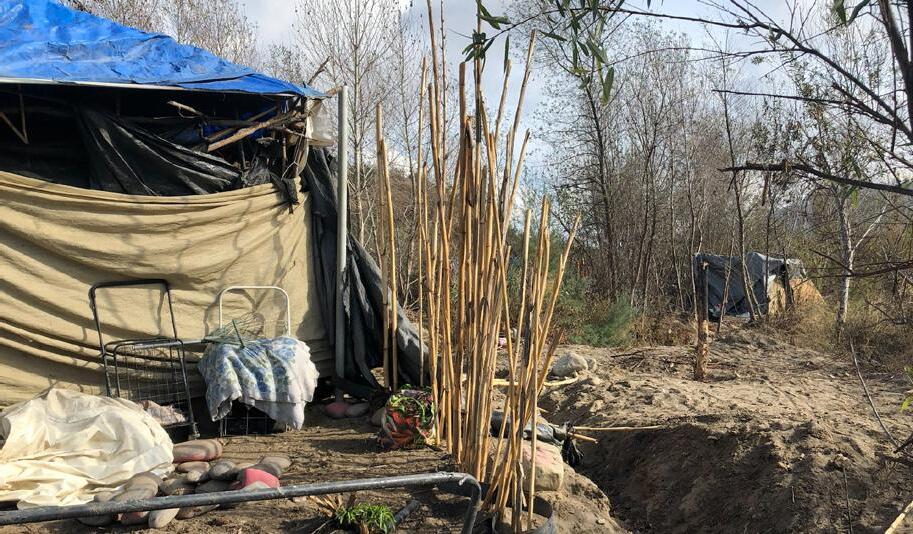











There were 1,990 adults and children who were counted as homeless during the point-in-time (PIT) count as noted in the chart below. This number represents a decrease of 368 persons or -15.6% when compared to the 2,358 persons who were counted as homeless in 2024. Since 2023, there has been an 18.5% decrease overall.
The total number of persons counted as sheltered and unsheltered decreased:
• The total number of persons counted as sheltered decreased from 927 in 2024 to 716 in 2025, which represents a decrease of 211 persons or 22.8%.
• The total number of persons counted as unsheltered decreased from 1,431 in 2024 to 1,274 in 2025, which represents a decrease of 157 persons or 11%.
The decrease in shelter beds occurred due to the conversion of Project Roomkey motels to Homekey permanent supportive housing units, as well as a shift in Domestic Violence transitional housing to rapid rehousing units. These are major accomplishments for Ventura County by ending homelessness for many individuals and families between 2024 to 2025.
Also, the decrease in the number of unsheltered persons continues as there have been more investments in State grant funding to address encampments and the priority of homelessness prevention to help people retain housing.
The results of the Homeless Count play a vital role in identifying trends and gaps, guiding community leaders in allocating funding to areas of highest need. The key takeaways include:
1) Permanent Housing Solutions: Over 100 permanent housing units opening in 2024 as well as an expansion of rapid rehousing programs offering rental assistance have resulted in reductions in the number of persons experiencing homelessness.
2) Prevention Efforts: Dedicated funds for homelessness prevention and landlord engagement are helping to address first time homelessness.
3) Encampment Interventions: State grant investments and continued efforts by the County of Ventura and cities have resolved encampments by prioritizing housing placements, delivering a measurable community impact.
Regarding sheltered homelessness, the U.S. Department of Housing and Urban Development (HUD) states that:
• CoCs must count all individuals or families who meet the criteria in paragraph (1)(ii) of the homeless definition in 24 CFR 578.3. This includes individuals and families “living in a supervised publicly or privately operated shelter designated to provide temporary living arrangements (including congregate shelters, transitional housing, and hotels and motels paid for by charitable organizations or by federal, state, or local government programs for low-income individuals)” on the night designated for the count. This includes individuals residing in Safe Haven projects.
Regarding unsheltered homelessness, HUD states that:
• CoCs must count all individuals or families who meet the criteria in paragraph (1)(i) of the homeless definition in 24 CFR 578.3. This includes individuals and families “with a primary nighttime residence that is a public or private place not designed for or ordinarily used as a regular sleeping accommodation for human beings, including a car, park, abandoned building, bus or train station, airport, or camping ground” on the night designated for the count. Rapid ReHousing (RRH) assisted households who are still unsheltered on the night of the count (e.g., staying in an encampment and being assisted by an RRH project to obtain housing) must be included as part of the unsheltered count.
Table 2 provides a breakdown of the 2025 homeless count by sheltered and unsheltered persons for each jurisdiction. Among cities, Oxnard had the largest number of unsheltered persons (379) and the largest number of sheltered persons (255). The City of Ventura had the second largest number of unsheltered (281) and sheltered persons (241).


TABLE 2. Total Number of Sheltered and Unsheltered Adults and Children by Jurisdiction in 2025
*Ojai unsheltered data includes tent town encampment.
**Includes Safe Haven beds.
***Domestic Violence (DV) Shelter locations are not disclosed and thus are reported here. Project Roomkey non-congregate shelters are counted in the Countywide data, as persons are served from various cities.
Table 3 compares the total number of unsheltered persons, sheltered persons and the total number of persons counted in 2025 to the same totals for 2024.
TABLE 3. 2024 - 2025 Comparison of Unsheltered and Sheltered Persons by Jurisdiction
*Sheltered persons include emergency shelters, transitional housing, and safe havens.
**percentages are only provided for differences that were 200% or less.
***Includes Survivors of Domestic Violence (DV) programs.

The U.S. Department of Housing and Urban Development (HUD) requires local jurisdictions receiving Continuum of Care (CoC) funding to conduct a “one-day point-in-time” unsheltered and sheltered homeless count, at least every other year since 2005, during the last 10 days of January. However, since 2012, HUD requires a sheltered count every year, which includes emergency shelters and transitional housing programs, including safe havens. The Ventura County CoC has conducted an annual unsheltered and sheltered count since 2009 with the exception of 2021 which only included those sheltered due to the COVID-19 pandemic.
In addition, HUD requires local jurisdictional applicants to gather data for the following subpopulations: chronically homeless individuals, chronically homeless families, persons with mental illness, persons with HIV/AIDS, substance users, veterans, victims of domestic violence, unaccompanied youth under age 18, and youth ages 18 – 24.
A. When were the 2025 Count and Subpopulation Surveys conducted?
The homeless count and subpopulation surveys were conducted on January 22, 2025 to survey persons who slept sheltered or unsheltered on the night of January 21, 2025. Additionally, HUD allows for communities to survey persons at service site locations and other areas such as homeless encampments within seven days following the night of the count. In Ventura County, each community lead identified service sites and other areas to survey. Service providers, volunteers and law enforcement partners assisted with surveying these locations on days following the count, including encampments. The person had to report sleeping in a “place not meant for human habitation” on the night of January 21, 2025 to be included in the count. Identifier information was collected to prevent duplication.
The local Homeless Management Information System (HMIS) was used to complete the sheltered count on the same day. Those agencies that operate an emergency shelter or transitional housing program and do not participate in HMIS completed a survey with the same information as collected in HMIS.
B. Who was counted and surveyed in 2025?
Only those persons who met HUD’s definition of homelessness were counted and surveyed. HUD considers a person homeless only when he/she lives:
• In places not meant for human habitation, such as cars, parks, sidewalks, and abandoned buildings;
• In an emergency shelter;
• In transitional housing; and
• In a safe haven.
HUD does not consider the following persons to be homeless— persons who are “doubled up,” or persons who are “near homelessness”—but considers them to be at-risk of becoming homeless. Such persons were not included in the homeless count. The latest Census Bureau data (2023, census.gov) noted that 9.8% or approximately 81,871 of the county’s 835,427 residents or approximately 27,565 households in the County were living below the poverty level. These households are at risk of becoming homeless based on social structural issues such as increases

in rent, loss of job, and rising health care costs. In addition, personal experiences such as domestic violence, physical disabilities, mental illness, and substance abuse can cause members of a low-income household or an entire household to become homeless. Often, one or more of these experiences factor into a household’s homeless experience as suggested in Table 12.
During program year 2024, the Ventura County Continuum of Care homeless services system saw 6,000 persons including 5,063 adults and 1,400 persons in families, including 861 children. 29% of those served by homeless service providers in 2024 were seniors (55 and older). A total of 4,543 referrals were made to programs including homeless prevention assistance, emergency shelter, transitional housing, and rapid re-housing. 47% of persons served were assisted with permanent housing or transitioned to positive housing destinations. While the system continues to experience challenges in identifying affordable and available housing units for all persons that need them, persons in permanent housing programs (rapid re-housing and permanent housing) saw a greater than 95% success rate in retaining permanent housing. The 42 participating partner agencies and their various programs are successful in finding positive placements and support those households in achieving housing stability when the right resources are available.
Ventura County 211 continued to receive a high number of calls for housing assistance in 2024; however, there was a 12% decrease from the prior year in calls from those at risk of homelessness, from 1,238 in 2023 to 1,086 in 2024. The charts below show calls from persons who were at-risk of homelessness or currently unhoused in each jurisdiction.
VC CONTINUUM OF CARE
4,543 referrals
47% were assisted with permanent housing 95% success rate in retaining permanent housing
The County of Ventura Healthcare for the Homeless reported 2,753 persons enrolled that met the Health Resources & Services Administration (HRSA) definition of homeless (includes doubled-up and at-risk persons). Of this number, approximately 90% (2,478) were literally homeless (on the streets, emergency shelter or transitional housing).
The Ventura County Office of Education also tracks the number of homeless students through a broader definition of homelessness set by the Federal Department of Education. Currently, 8,800 students are classified under the McKinney Vento Act in 2024, an increase of over 1,400 students from the prior year. 8,400 students were temporarily doubled up or at-risk of homelessness. Approximately 400 students met the HUD definition of homelessness. This data includes all public K-12 schools in Ventura County.
C. Who carried out the count and subpopulation survey?
Each city jurisdiction and unincorporated areas had volunteer teams that were coordinated by a team leader(s). Approximately 400 volunteers helped with the unsheltered count and subpopulation survey. Teams counted on the streets, in encampments, and at non-residential program sites that served homeless persons such as one stop services and public assistance sites.
Volunteer efforts were coordinated by the County Executive Office (CEO), which is responsible to the Board of Supervisors for the general administration and coordination of all County operations and programs (see ventura.org/county-executive-office). The CEO’s office also provides staff support to the Countywide Continuum of Care. The CEO staff consulted with the Institute for Urban Initiatives to complete the count and subpopulation survey.
Urban Initiatives is a community-based research and development agency that has completed many housing and homeless assessments including several homeless counts for cities and counties throughout Southern California. It consists of several agencies that respond to the economic, housing, and social needs of neighborhoods, cities, and counties from community, regional, national, international, and faith-based perspectives (see urban-initiatives.org).
The CEO staff also consulted with the Ventura County Continuum of Care Alliance (VCCCA), whose mission is to facilitate an end to homelessness in Ventura County by coordinating funding, housing, and service strategies that prevent and end homelessness to plan and coordinate the count. The VCCCA is made up of individuals and representatives who support the mission, including those from the service sector (mental health agencies, health care agencies, social service providers, victim advocates, and educational institutions), housing agencies (non-profit and for-profit developers, housing authorities), law enforcement, and advocates (faith community, formerly homeless and neighborhood groups). For more information about VCCCA, visit coc.venturacounty.gov.
Ventura County first conducted a homeless count and subpopulation survey in 2007 as listed in Table 4. The homeless count and survey have been conducted every year beginning in 2009 except in 2021 (see note below).
*VC CoC received an exception from HUD not to conduct an unsheltered count because of pandemic related reasons.
The next chart shows that the number of persons counted as homeless has decreased by 18.5% over the past two years. This significant progress occurred due to investments in permanent supportive housing. The number of persons counted as homeless in 2020 was 1,743 and 1,990 persons in 2025, which represents an increase over a five-year period of 247 persons or 14.2%.
The next table provides the number of homeless persons counted since 2007 by cities and unincorporated areas. The countywide data includes domestic violence programs in locations that are not disclosed, project roomkey non-congregate shelters, and unincorporated areas. A count was not conducted in 2008 and an exception was granted by HUD not to conduct an unsheltered count in 2021 due to the COVID-19 pandemic.
TABLE 5. Comparison of the total number of homeless persons counted since 2007 by cities
*This number was artificially low due to an unresolved reporting discrepancy and the winter shelter being located in Ventura.
**An unsheltered count was not conducted because of pandemic related reasons.
TABLE 5. (continued)
**An unsheltered count was not conducted because of pandemic related reasons.



f the 1,990 persons counted in 2025, 1,274 or 63.8% were unsheltered, which is defined by the U.S. Department of Housing and Urban Development (HUD) as
“An individual or family who lacks a fixed, regular, and adequate nighttime residence, meaning: (i) An individual or family with a primary nighttime residence that is a public or private place not designed for or ordinarily used as a regular sleeping accommodation for human beings.”
Of the 1,274 unsheltered persons, 1,257 were adults and 17 were accompanied children under age 18.
Of the 11 jurisdictions, four include a total of 10 families with children under age 18. The cities of
• Simi Valley includes three families with six children consisting of one family with 1 adult and two children, one family two adults with one child, and one family with two adults and three children;
• Oxnard includes four families with seven children consisting of one family with one adult and one child, one family with two adults and one child, one family with two adults and two children, and one family with two adults and three children;
• Thousand Oaks includes one family with two adults and one child;
• Camarillo includes two families with 3 children consisting of one family with two adults and one child and one family with three adults and one child (note: one adult was a youth age 18 – 24).
The goal was to survey, meaning to interview, as many adults who were counted about themselves and any children who were living unsheltered with them. Survey questions focused on requirements from HUD and local information desired by the Ventura County Continuum of Care (VC CoC). The number and percentage of adults surveyed is noted in Table 4.
2025 COUNT
1,990 persons counted
1,274 (63.8%) unsheltered
1,257 adults
17 accompanied children under age 18
HUD requires CoCs to report the number of various subpopulations that include chronically homeless individuals and families, persons with serious mental illness, substance use disorders, AIDS or an HIVrelated illness, and veterans. The CoC desired local information included a focus on chronic health conditions, first time homelessness, foster youth, income, veterans and those self-reporting involvement with the justice system.
Counters surveyed 838 adults that answered questions about themselves and their households. The survey included questions about gender, age, race, ethnicity, and length of time homeless for adults and children. Other questions about disability, health, mental health, substance use, income, and veteran status pertained only to adults.
Persons who were observed and not surveyed if volunteer counters felt unsafe or an unsheltered person was sleeping. Volunteers were asked to count the person by recording an estimate of the individual’s
gender, age, race, and ethnicity. Of the 422 persons observed, 419 were adults and 3 were children in families.
The survey and observation rates were nearly the same in 2024 and 2025 as noted in Table 6 below. Training was offered in January 2025 to review the mobile app and emphasize the importance of full surveys when possible. Full surveys assist with a more accurate count and provide more details with subpopulation data.
TABLE 6. Total Number and Percent of Unsheltered Adults Surveyed and Observed
The next table provides a breakdown of the total number and percent of adults surveyed and observed by jurisdiction. Of the 1,274 persons counted as unsheltered in 2025, 1,257 were adults. The remaining 17 persons were children under age 18 that are part of family households.
TABLE 7. Total Number and Percent of Unsheltered Adults Surveyed and Observed by Jurisdiction
*Observations include those who declined or refused to be surveyed.
The following four tables focus on gender, ethnicity, race, and age for the 1,274 unsheltered adults and children who were surveyed and observed.
The following table provides a breakdown by gender for the 1,257 adults and 17 children under age 18 in families. HUD requires the summary to consist of male, female, transgender, non-binary, questioning, different identity, more than one gender, culturally specific identity, and unknown.


Table 9 provides a breakdown by race and ethnicity for the 1,257 adults and 17 children under age 18 in families. HUD requires the summary to consist of Hispanic/Latin(a)(o)(x) and Non-Hispanic/ Latin(a)(o)(x).
Table 10 provides a breakdown by age of the 1,257 adults and 17 children under age 18 in families.
TABLE 10. Unsheltered Adults and Children by Age


Table 11 only includes self-reported responses from the 1,257 adults. The most notable finding concerns chronically homeless adults. Nearly half (48.0%) of adults were chronically homeless in 2024. However, In 2025, approximately one-third (36.0%) of adults were chronically homeless.
* In 2024, 10 families consisted of 44 persons of which 25 were adults and 19 were children. Of the 10 families, 5 were chronically homeless and included 14 adults and 10 children.
**In 2025, 10 families consisted of 36 persons of which 19 were adults and 17 were children. Of the 10 families, 3 were chronically homeless and included 6 adults and 5 children.
Did you become homeless for the first time in the last 12 months?
The next chart shows that the percentage of unsheltered adults who became homeless for the first time during the past 12 months is similar to the previous year and decreasing since 2023. Nearly one-fourth (24%) of unsheltered adults in 2020, nearly one-third (32%) in 2022, more than one-third (39%) in 2023 and less than one-fourth in 2024 (17%) and 2025 (19%).
Additional resources for homelessness prevention have been dedicated through the State of California and Ventura County Continuum of Care. The rental assistance, utility assistance and landlord engagement have provided more stability for many households who were at risk of homelessness during program year 2024. Additional investments have been made in homelessness prevention programs through the State Homeless Housing Assistance and Prevention (HHAP) Program, administered by the Ventura County Continuum of Care, County of Ventura Human Services Agency, and United Way of Ventura County.
Do you have any family or friends that you would like to reconnect with even if you do not currently know how to reach them?
TABLE 11. Other Survey Questions (continued)



A homeless count and subpopulation survey instrument was used to gather unsheltered data by volunteer counters. The survey data was gathered primarily by utilizing the Simtech Solutions Counting Us mobile app.
A digital survey form was designed to simplify the surveyor’s experience; only relevant questions were displayed based on the answers already entered, eliminating the need for surveyors to devote time and effort to determine which questions to ask, and resulting in a simpler linear surveying experience.
Volunteers entered responses to survey questions on their mobile devices where survey data was instantly submitted to a regional command center. The survey questions were focused on gathering demographic information and subpopulation as required by HUD. The instrument focused on gathering responses that were used to create an identifier and to determine the number of persons for each subpopulation required by HUD. All information gathered through this instrument remains confidential.
During the count, volunteers collected the following information from each person that was surveyed: first initial of first name, first initial of last name, gender, race , age by code , and physical disability. The information for each encounter was exported into a database. The information was used to create an identifier for each person. For example, a homeless person may have the following code of “WTM56Y.” This means that this person’s first name began with “W”, last name began with “T”, he was male “M”, he was White “5”, in the age range of 45-54 “6”, and said “yes” when asked if they had a physical disability.
If the same identifier appeared more than once, it was assumed that this was the same person and the person would only be counted once. An example to illustrate how this process worked is noted in the table below. Numbers 6 and 7 (shaded in gray) would be considered the same person. If for some reason there was doubt that numbers 6 and 7 were the same person, other data collected on the same two people would be used to address the doubt.
The data also provided the opportunity to break down the number of homeless persons counted by gender, ethnicity, age range, and state born. Thus, the questions served two purposes—basic demographic information and the prevention of duplication.
¹ The code for race was 1=African American or Black; 2=American Indian or Alaskan Native; 3=Asian; 4=Native Hawaiian or Pacific Islander; 5=White; 6=Multiple Races or Other, 7= Don’t Know; and 8= Refused to Answer.
² The code for age included: 0=under 5; 1=5-12; 2=13-17; 3=18-24; 4=25-34; 5=35-44; 6=45-54; 7=55-61; and 8=62+.
The survey instrument also focused on gathering responses to several questions to determine the number of persons for each of the eight subpopulations required by HUD, which include:
• Chronically Homeless Individuals;
• Chronically Homeless Families;
• Persons with HIV/AIDS;
• Persons with Chronic Substance Abuse;
• Persons with Severe Mental Illness;
Other subpopulation data was also collected for:
• Unaccompanied Youth under Age 18;
• Veterans;
• Persons fleeing Domestic Violence; and
• Youth Ages 18 to 24.
• Persons released from jail during past 12 months after serving a court-ordered sentence;
• Persons with a Physical Disability;
• Persons with a Developmental Disability;
• Persons with Chronic Health Conditions; and
• Seniors age 62+.
A HUD approved extrapolation methodology was used to estimate population demographics for the observation surveys. This methodology applies the surveyed proportion of demographic data to the total population experiencing homelessness for an extrapolated estimate.
As required by HUD, the sheltered count included the number of persons and households sleeping in emergency shelters (including seasonal shelters) and transitional housing, which were listed on the Housing Inventory Chart (HIC) (see Appendix D). In addition, any persons staying in hotels or motels as a result of receiving a voucher from a social service agency were included in the sheltered count per HUD’s instructions if the voucher program was listed on the HIC.
The HIC is updated and submitted to HUD in May of each year, as part of the annual Point-in-Time count process. Prior to the homeless count, the HIC was updated by CEO staff to include any new programs or exclude any programs no longer operational.
HUD encourages the use of HMIS data to generate sheltered counts and subpopulation data for programs with 100% of beds participating in HMIS. Thus, HMIS was used to gather the total number of occupied beds and the number of persons for each subpopulation. Data was also collected on the total number of occupied beds and the number of persons for each subpopulation for non-participating HMIS programs. The same questions used to collect subpopulation data through HMIS were used for the data collection instrument

This section provides a breakdown of each of the following unsheltered subpopulations:
• Chronically homeless adults
• Veterans
• Youth ages 18 – 24


*Several questions were asked to determine if the adult met HUD’s definition of chronic homelessness which is an individual with a disability as defined in section 401(9) of the McKinney-Vento Assistance Act (42 U.S.C. 11360(9)) and who lives in a place not meant for human habitation, a safe haven, or in an emergency shelter, and has been homeless and living as described for at least 12 months* or on at least 4 separate occasions in the last 3 years, as long as the combined occasions equal at least 12 months.
Do


*Several questions were asked to determine if the adult met HUD’s definition of chronic homelessness which is an individual with a disability as defined in section 401(9) of the McKinney-Vento Assistance Act (42 U.S.C. 11360(9)) and who lives in a place not meant for human habitation, a safe haven, or in an emergency shelter, and has been homeless and living as described for at least 12 months* or on at least 4 separate occasions in the last 3 years, as long as the combined occasions equal at least 12 months.

he Ventura County Continuum of Care (VC CoC) Board is dedicated to promoting a safe, desirable and thriving community by dedicating resources to prevent and end homelessness in Ventura County. The following recommendations from the VC CoC Board are aligned with the Ventura County Homelessness Plan which was adopted by the Ventura County Board of Supervisors in December 2023. The full plan can be found on the VC CoC website here: venturacoc.org
1
Achieve functional zero with homeless veterans in 2025 in collaboration with Veteran Affairs and local veteran service providers;
2 Further the efforts to end homelessness among unsheltered youth with the expansion of new transitional housing programs for transitional-age-youth (18-24);
3
4
5
6
7
Reduce the number of chronically homeless adults by 2025 with the addition of new permanent supportive housing units;
Encourage each jurisdiction to review their 2025 unsheltered homeless count and align local strategies to reduce unsheltered homelessness;
Expand the efforts of the Ventura County Continuum of Care Workgroup partnering with people with lived experience to solicit feedback and provide recommendations;
Reduce the number of first-time homeless households by expanding homelessness prevention programs and implementing diversion strategies;
Leverage resources to prioritize or increase supportive services for housing retention.



How many months did you stay in shelter or on the streets over the past 3 years?
*Several questions were asked to determine if the adult met HUD’s definition of chronic homelessness which is an individual with a disability as defined in section 401(9) of the McKinney-Vento Assistance Act (42 U.S.C. 11360(9)) and who lives in a place not meant for human habitation, a safe haven, or in an emergency shelter, and has been homeless and living as described for at least 12 months* or on at least 4 separate occasions in the last 3 years, as long as the combined occasions equal at least 12 months.
Do


*Several questions were asked to determine if the adult met HUD’s definition of chronic homelessness which is an individual with a disability as defined in section 401(9) of the McKinney-Vento Assistance Act (42 U.S.C. 11360(9)) and who lives in a place not meant for human habitation, a safe haven, or in an emergency shelter, and has been homeless and living as described for at least 12 months* or on at least 4 separate occasions in the last 3 years, as long as the combined occasions equal at least 12 months.
Do you have any family or friends that you would like to reconnect with even if you do not currently know how to reach them?
Do


How long in months have you been in this community?
How many months did you stay in shelter or on the streets over the past 3 years?
*Several questions were asked to determine if the adult met HUD’s definition of chronic homelessness which is an individual with a disability as defined in section 401(9) of the McKinney-Vento Assistance Act (42 U.S.C. 11360(9)) and who lives in a place not meant for human habitation, a safe haven, or in an emergency shelter, and has been homeless and living as described for at least 12 months* or on at least 4 separate occasions in the last 3 years, as long as the combined occasions equal at least 12 months.


How long in months have you been in this community?
How many months did you stay in shelter or on the streets over the past 3 years?
*Several questions were asked to determine if the adult met HUD’s definition of chronic homelessness which is an individual with a disability as defined in section 401(9) of the McKinney-Vento Assistance Act (42 U.S.C. 11360(9)) and who lives in a place not meant for human habitation, a safe haven, or in an emergency shelter, and has been homeless and living as described for at least 12 months* or on at least 4 separate occasions in the last 3 years, as long as the combined occasions equal at least 12 months. **Slight variance due to rounding to the nearest whole integer.


*Several questions were asked to determine if the adult met HUD’s definition of chronic homelessness which is an individual with a disability as defined in section 401(9) of the McKinney-Vento Assistance Act (42 U.S.C. 11360(9)) and who lives in a place not meant for human habitation, a safe haven, or in an emergency shelter, and has been homeless and living as described for at least 12 months* or on at least 4 separate occasions in the last 3 years, as long as the combined occasions equal at least 12 months.


How long in months have you been in this community?
How many months did you stay in shelter or on the streets over the past 3 years?
*Several questions were asked to determine if the adult met HUD’s definition of chronic homelessness which is an individual with a disability as defined in section 401(9) of the McKinney-Vento Assistance Act (42 U.S.C. 11360(9)) and who lives in a place not meant for human habitation, a safe haven, or in an emergency shelter, and has been homeless and living as described for at least 12 months* or on at least 4 separate occasions in the last 3 years, as long as the combined occasions equal at least 12 months. **Slight variance due to rounding to the nearest whole integer


*Several questions were asked to determine if the adult met HUD’s definition of chronic homelessness which is an individual with a disability as defined in section 401(9) of the McKinney-Vento Assistance Act (42 U.S.C. 11360(9)) and who lives in a place not meant for human habitation, a safe haven, or in an emergency shelter, and has been homeless and living as described for at least 12 months* or on at least 4 separate occasions in the last 3 years, as long as the combined occasions equal at least 12 months. **Slight variance due to rounding to the nearest whole integer


*Several questions were asked to determine if the adult met HUD’s definition of chronic homelessness which is an individual with a disability as defined in section 401(9) of the McKinney-Vento Assistance Act (42 U.S.C. 11360(9)) and who lives in a place not meant for human habitation, a safe haven, or in an emergency shelter, and has been homeless and living as described for at least 12 months* or on at least 4 separate occasions in the last 3 years, as long as the combined occasions equal at least 12 months. **Slight variance due to rounding to the nearest whole integer.
Oaks Total Number of Unsheltered Persons: 162


*Several questions were asked to determine if the adult met HUD’s definition of chronic homelessness which is an individual with a disability as defined in section 401(9) of the McKinney-Vento Assistance Act (42 U.S.C. 11360(9)) and who lives in a place not meant for human habitation, a safe haven, or in an emergency shelter, and has been homeless and living as described for at least 12 months* or on at least 4 separate occasions in the last 3 years, as long as the combined occasions equal at least 12 months. **Slight variance due to rounding to the nearest whole integer.


*Several questions were asked to determine if the adult met HUD’s definition of chronic homelessness which is an individual with a disability as defined in section 401(9) of the McKinney-Vento Assistance Act (42 U.S.C. 11360(9)) and who lives in a place not meant for human habitation, a safe haven, or in an emergency shelter, and has been homeless and living as described for at least 12 months* or on at least 4 separate occasions in the last 3 years, as long as the combined occasions equal at least 12 months. **Slight variance due to rounding to the nearest whole integer.
Number of Unsheltered Persons: 84


*Several questions were asked to determine if the adult met HUD’s definition of chronic homelessness which is an individual with a disability as defined in section 401(9) of the McKinney-Vento Assistance Act (42 U.S.C. 11360(9)) and who lives in a place not meant for human habitation, a safe haven, or in an emergency shelter, and has been homeless and living as described for at least 12 months* or on at least 4 separate occasions in the last 3 years, as long as the combined occasions equal at least 12 months. **Slight variance due to rounding to the nearest whole integer.



The number of homeless families with children in Emergency Shelters and Transitional Housing decreased from 108 households in 2024 to 76 households sheltered in 2025. This data includes families staying in non-congregate shelters through motel voucher programs and those in domestic violence shelters.


There has been a decrease in the number of single adults in Emergency Shelter and Transitional Housing, from 584 in 2024 to 514 in 2025, as non-congregate shelters have been operating through Project Roomkey motels and Non congregate motel vouchers funded by State Homeless Housing Assistance and Prevention Funding. Project Roomkey was supported through FEMA and State COVID response funding for those who were unsheltered and highly vulnerable to COVID-19, including seniors 65 & older and those with serious health conditions.
*This chart shows a subpopulation of Transitional Age Youth (TAY) from the single adults category.



In HMIS
LEGEND
Populations: DV - Domestic Violence, TAY - Transitional Age Youth (18-24), N/A - Not applicable Domestic Violence Program
New Program 2025
Project Type: ES - Emergency Shelter, SH - Safe Haven Not in HMIS


New Program 2025
Permanent Housing Inventory: Permanent Supportive Housing, Other Permanent Housing and Rapid Re-Housing (continued)
Permanent Housing Inventory: Permanent Supportive Housing, Other Permanent Housing and Rapid Re-Housing (continued)
Permanent Housing Inventory: Permanent Supportive Housing, Other Permanent Housing and Rapid Re-Housing (continued)
Permanent Housing Inventory: Permanent Supportive Housing, Other Permanent Housing and Rapid Re-Housing (continued)
Permanent Housing Inventory: Permanent Supportive Housing, Other Permanent Housing and Rapid Re-Housing (continued)
Note: Projects under development are scheduled to open in 2025 and are not included in PIT/HIC data.
CH - Chronically Homeless, ES - Emergency Shelter, HIC - Housing Inventory Count, OPH - Other Permanent Housing, PBV - Project Based Voucher, PH - Permanent Housing, PIT - Point In Time Count, PSH - Permanent Supportive Housing, VASH - Veteran Affairs Supportive Housing






Many thanks to the 400 volunteers and organizations that contributed to the success of the 2025 Homeless Count! The collaboration and efforts of our community volunteers, community groups, faith- and community-based organizations, county departments, city representatives and staff, homeless service providers, law enforcement and elected officials is greatly appreciated, as this comprehensive data is critical to effectively plan and provide resources to the most vulnerable populations in our community.
Jason Havelka, County of Ventura Ventura County Sheriff’s Department (VCSD)
Christina Villasenor, City of Fillmore Ventura County Sheriff’s Department (VCSD)
Moorpark
Morgan Saveliff, County of Ventura Ventura County Sheriff’s Department (VCSD)
Whitney Nunes, Help of Ojai Ventura County Sheriff’s Department (VCSD)
Michael Skinner, City of Oxnard Oxnard Police Department
Port Hueneme
Christina Cabral, County of Ventura Port Hueneme Police Department
Santa Paula
Nomi Marrufo, SPIRIT of Santa Paula Santa Paula Police Department
Simi Valley
Cynthia McCullough, City of Simi Valley Simi Valley Police Department
Thousand Oaks
Rick Schroeder, Many Mansions
Hannah Blitstein, Many Mansions
Ventura County Sheriff’s Department (VCSD)
Ventura
Leona Rollins, City of Ventura
Lee Sherman, City of Ventura
Ventura Police Department
Other Key Partners
Food Share of Ventura County
Gold Coast Veterans Foundation
Harbor House
Interface Children and Family Services
Lutheran Social Services
Many Mansions
Mercy House
National Health Foundation
Pacific Clinics TAY Tunnel
Project Understanding
Salvation Army
Samaritan Center
SPIRIT of Santa Paula
Turning Point Foundation
United Way of Ventura County
Ventura County Area Agency on Aging
Ventura County Behavioral Health
Ventura County Community Foundation
Ventura County Health Care Agency
Ventura County Human Services Agency
Ventura County Libraries
Ventura County Office of Education
Ventura County Rescue Mission
Ventura County Sheriff’s Department (VCSD)
The Ventura County Continuum of Care would also like to thank Dr. Joe Colletti and the Urban Initiatives staff for their expertise in the 2025 Homeless Count planning, coordination, data analysis and assistance in preparing this report. Urban Initiatives (urban-initiatives.org/) is a community-based non-profit research organization that has extensive experience conducting Point-In-Time counts throughout Southern California.


